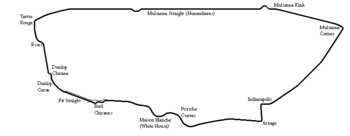
Back 24-Stunden-Rennen von Le Mans 1991 German Le Mansin 24 tunnin ajo 1991 Finnish 24 Heures du Mans 1991 French 1991-es Le Mans-i 24 órás verseny Hungarian Le Mans 24 Jam 1991 ID 24 Ore di Le Mans 1991 Italian 1991年のル・マン24時間レース Japanese 24 uur van Le Mans 1991 Dutch 24h Le Mans 1991 Polish 24 Horas de Le Mans de 1991 Portuguese
| |||


The 1991 24 Hours of Le Mans was the 59th Grand Prix of Endurance, taking place at the Circuit de la Sarthe, France, on the 22 and 23 June 1991. It was also the fourth round of the 1991 FIA Sportscar World Championship season.
This was the inaugural season of the new 3.5-litre non-turbo regulations for Sports Cars, however the number of teams entering cars in that class was very limited, so the entry list was opened up to the old Group C category. To promote their new formula, FISA decreed that the top ten grid spots had to be taken by cars in the new class, regardless of their qualifying time, with the Group C cars arranged behind them. The piston-engine Group C cars were penalised to carry 100 kg extra ballast, but the rotary-engine Mazdas were not.
The race was anticipated to be a final showdown between Jaguar and Sauber-Mercedes, with Porsche, Mazda and the new Peugeots playing supporting roles. Indeed, from the front of the grid, the Peugeots did lead for the first hour, but their reliability failed them, and they were soon in the pits to eventually retire. It was then that the Mercedes cars that took up the lead, even running positions 1-2-3 for several hours. The Jaguars were being stymied by fuel consumption and had to temper their pace accordingly. Nevertheless, the three cars stayed in the top-10, fighting with the two new Mazda 787Bs.
By the halfway point, the Schlesser/Mass/Ferté Mercedes were up by a lap over their teammates, the Junior team of Wendlinger/Schumacher/Kreutzpointner, and by three laps over their nearest opponents, the Mazda of Weidler/Herbert/Gachot. Within an hour though, Wendlinger brought his car into the pits stuck in fourth gear. The Mazda was lapping faster than the Mercedes but was unable to make a serious dent in the margin. As the new day dawned, the Jaguars were successively delayed by off-road excursions and engine problems. The leading Joest Porsche had been running as high as fourth but came to a stop out on the track.
After leading for almost 17 hours, the leading Mercedes came into the pits with its temperature skyrocketing. The belt on the waterpump had come off and stopped the engine cooling – a similar issue to what had struck the third team-car a few hours earlier. The damage was terminal, and the Mazda screamed past into the lead with three hours to go. Their run had been very reliable, and although the Jaguars tried to push, Herbert brought home the Mazda to win by two laps over the IMSA-team Jaguar of Jones/Boesel/Ferté. The Mercedes-Junior team lost a place in the last hour but survived to finish fifth and win the Index of Energy Efficiency. Michael Schumacher also set a new lap record, beating the previous one by five seconds. Only 12 cars were classified at the finish, including just a single entry from the new Category 1.